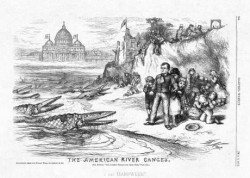(Published March 16, 2017; Updated March 16, 2018)
As New York prepares for the St. Patrick’s Day parade, here is another reminder of the past view of the Irish–especially Irish Catholics– in America: the Orange Riots of 1870 and 1871.

The Orange Riot of 1871 as depicted in Frank Leslie’s Illustrated Newspaper. The view is at 25th Street looking south down Eighth Avenue (Source Wikipedia: https://en.wikipedia.org/wiki/Orange_Riots#/media/File:Orange_Riot_1871_crop.jpg)
Long before the nation’s birth, anti-Catholic venom was an accepted American truism –a deep divide with roots in Europe’s deadly wars between Catholic and Protestant. The hatred of all things Roman Catholic was part of America’s Puritan and Protestant roots. In 1844, Philadelphia had been raked by anti-Catholic violence known as the “Bible Riots,” subject of a previous post.
By the middle of the 19th century, waves of Irish immigrants had magnified the hatred and transformed New York’s politics. Political boss William Tweed used their votes to secure power for Tammany Hall and himself. But the growth of Irish Catholic power in New York only deepened ancient animosities.
New York’s virulent anti-Catholic sentiment peaked with the largely overlooked “Orange Riots” of 1870 and 1871. In the first of these, Irish Protestants marched in celebration of the July 12, 1690 victory of the Protestant King William III over Catholic King James II at the Battle of the Boyne. Taunting Irish Catholic workmen as they paraded up Eighth Avenue, the Protestant “Orangemen” went to a park where a pitched battle ensued.

Thomas Nast’s Anti-Catholic cartoon “The American River Ganges snd the Children” Harpers’Weekly September 30, 1871
Eight people died.
Another “Orange Day” march planned in 1871 was nearly banned for public safety reasons. But prominent businessmen and cartoonist Thomas Nast objected vehemently to this affront to Protestant rights. With Boss Tweed guaranteeing protection for the marchers, the 1871 parade stepped off, guarded by some 5,000 policemen and National Guard militia units.
Almost immediately, the marchers were pelted with bottles, bricks, shoes and stones. Pitched battles continued along the parade route. When it was over, the rioting and street-fighting left sixty people dead, most of them Irish Catholic laborers as well as three Guardsmen.
The bloodshed of these “Orange Riots” and Tweed’s failure to secure the parade were crucial factors in breaking his stranglehold on New York politics and government. The city’s newspapers and largely Protestant-controlled business and financial world turned on him. Tweed was deposed, eventually arrested, and later convicted of corruption.
Anti-Irish sentiment in New York and elsewhere continued for decades.